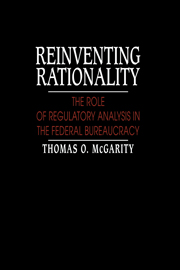Book contents
- Frontmatter
- Contents
- Acknowledgments
- Abbreviations
- Introduction
- Part I The clash of regulatory cultures
- Part II Regulatory analysis in theory and practice
- Part III Structuring regulatory analysis into the decisionmaking process
- Part IV Review of regulatory analysis
- 18 Office of Management and Budget review of regulatory analysis
- 19 Judicial review of regulatory analysis
- Part V Conclusions
- Notes
- Bibliography
- Index
19 - Judicial review of regulatory analysis
Published online by Cambridge University Press: 16 October 2009
- Frontmatter
- Contents
- Acknowledgments
- Abbreviations
- Introduction
- Part I The clash of regulatory cultures
- Part II Regulatory analysis in theory and practice
- Part III Structuring regulatory analysis into the decisionmaking process
- Part IV Review of regulatory analysis
- 18 Office of Management and Budget review of regulatory analysis
- 19 Judicial review of regulatory analysis
- Part V Conclusions
- Notes
- Bibliography
- Index
Summary
The two primary sources of regulatory analysis requirements for federal agencies – the Regulatory Flexibility Act (RFA) and the Executive Orders – have envisioned a very modest role for regulatory analysis in judicial review of rulemaking. Both the act and the Executive Orders specifically preclude judicial review of an agency's failure to prepare a regulatory analysis document. Thus, the regulatory analysis requirement varies significantly from the environmental impact statement requirement, which spawned a decade's litigation over threshold questions.
When an agency does prepare a regulatory analysis document, its failure to comply with the criteria specified in the statute and the Executive Orders is likewise not subject to judicial review. In Small Refiners Lead Phase-Down Task Force v. EPA, the case in which the lead phasedown rulemaking described in Chapter 3 was reviewed, the court held that although the contents of the RFA could properly be scrutinized by a reviewing court as part of its substantive review function, the failure of an RFA to meet all of the statute's content requirements was not properly subject to judicial review. The court acknowledged that “in an appropriate case” a reviewing court could strike down an agency rule because of a defect in the RFA, but such a case would exist only when the defect in the reviewing court's analysis of the reasonableness of the underlying rule. Assuming that the Regulatory Impact Analysis (RIA), like the RFA, can be useful to the courts' substantive review function, this chapter will explore how the courts can put regulatory analysis documents to their best use.
- Type
- Chapter
- Information
- Reinventing RationalityThe Role of Regulatory Analysis in the Federal Bureaucracy, pp. 292 - 300Publisher: Cambridge University PressPrint publication year: 1991



